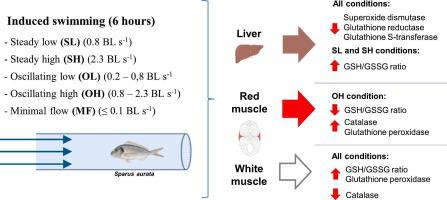Comparative Biochemistry and Physiology B: Biochemistry & Molecular Biology ( IF 2.2 ) Pub Date : 2023-08-20 , DOI: 10.1016/j.cbpb.2023.110893 Carlos Espírito-Santo 1 , Carmen Alburquerque 2 , Francisco A Guardiola 2 , Rodrigo O A Ozório 3 , Leonardo J Magnoni 4

|
Swimming has relevant physiological changes in farmed fish, although the potential link between swimming and oxidative stress remains poorly studied. We investigated the effects of different medium-term moderate swimming conditions for 6 h on the antioxidant status of gilthead seabream (Sparus aurata), analyzing the activity of enzymes related to oxidative stress in the liver and skeletal red and white muscle. Forty fish were induced to swim individually with the following conditions: steady low (SL, 0.8 body length (BL)·s−1), steady high (SH, 2.3 BL·s−1), oscillating low (OL, 0.2–0.8 BL·s−1) and oscillating high (OH, 0.8–2.3 BL·s−1) velocities, and a non-exercised group with minimal water flow (MF, < 0.1 BL·s−1). All swimming conditions resulted in lower activities of superoxide dismutase (SOD), glutathione reductase (GR), and glutathione-S-transferase (GST) in the liver compared to the MF group, while steady swimming (SL and SH) led to higher reduced glutathione/oxidized glutathione ratio (GSH/GSSG) compared to the MF condition. Swimming also differently modulated the antioxidant enzyme activities in red and white muscles. The OH condition increased lipid peroxidation (LPO), catalase (CAT) and glutathione peroxidase (GPx) activities in the red muscle, decreasing the GSH/GSSG ratio, whereas the SL condition led to increased GSH. Oscillating swimming conditions (OL and OH) led to lower CAT activity in the white muscle, although GPx activity was increased. The GSH/GSSG ratio in white muscle was increased in all swimming conditions. Liver and skeletal muscle antioxidant status was modulated by exercise, highlighting the importance of adequate swimming conditions to minimize oxidative stress in gilthead seabream.
中文翻译:

诱导游泳改变了金头鲷(Sparus aurata)的抗氧化状态
尽管游泳与氧化应激之间的潜在联系仍鲜有研究,但游泳对养殖鱼类具有相关的生理变化。我们研究了6小时不同中期适度游泳条件对金头鲷(Sparus aurata)抗氧化状态的影响,分析了肝脏和骨骼红白肌中与氧化应激相关的酶的活性。四十条鱼在以下条件下被诱导单独游泳:稳定低(SL,0.8体长(BL)·s -1),稳定高(SH,2.3 BL·s -1),振荡低(OL,0.2–0.8) BL·s -1)和振荡高(OH,0.8–2.3 BL·s -1 )速度,以及具有最小水流(MF,< 0.1 BL·s -1 )的非运动组。与 MF 组相比,所有游泳条件均导致肝脏中超氧化物歧化酶 (SOD)、谷胱甘肽还原酶 (GR) 和谷胱甘肽-S-转移酶 (GST) 的活性降低,而稳定游泳(SL 和 SH)导致肝脏中超氧化物歧化酶 (SOD)、谷胱甘肽还原酶 (GR) 和谷胱甘肽-S-转移酶 (GST) 的活性降低与 MF 条件相比的谷胱甘肽/氧化型谷胱甘肽比率 (GSH/GSSG)。游泳还以不同方式调节红肌和白肌中的抗氧化酶活性。OH 条件增加了红色肌肉中的脂质过氧化 (LPO)、过氧化氢酶 (CAT) 和谷胱甘肽过氧化物酶 (GPx) 活性,降低了 GSH/GSSG 比率,而 SL 条件导致 GSH 增加。振荡游泳条件(OL 和 OH)导致白肌中 CAT 活性降低,尽管 GPx 活性增加。在所有游泳条件下,白肌中的 GSH/GSSG 比率均有所增加。肝脏和骨骼肌的抗氧化状态通过运动进行调节,这凸显了充足的游泳条件对于最大限度地减少金头鲷氧化应激的重要性。



























 京公网安备 11010802027423号
京公网安备 11010802027423号